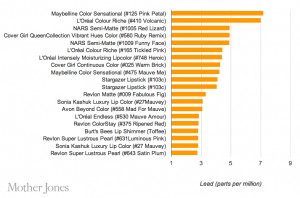Study reveals there’s more to your lipstick than you might know
I am not usually one for fear tactics: for telling people what to wear, where they should feel safe, what health means for every body. However, a recent article on the dangers of commercialized beauty by injury attorneys based in the United States caught my attention.
Over the past year, researchers have worked with a group of teenage girls to test their daily lipsticks and glosses for toxic metals. While there was a range of aluminum, cadmium, chromium, and manganese within the samples, the young women who applied these products onto their lips two to three times daily received more than 20 percent of the daily amount considered safe within drinking water. Meanwhile, approximately 75 percent of the samples in this American study had traces of lead, a metal that humans need to avoid entirely. This article is not about fear. It is about empowering the choice and the personhood that puts people in control of what goes on, and ultimately into, their bodies.
No woman (or man) (or anyone in between) should be harmed for putting on 12 layers of lipstick.
The attorneys argue that the Food and Drug Administration (FDA) is unable to officially protect cosmetics-buyers because they do not need pre-market approval. In fact, the Environmental Working Group (EWG) had to pay $175 per product to pay a lab without governmental funding to discover what good and harmful chemicals went unlabelled. The Federal Food, Drug, and Cosmetic Act does not authorize the FDA to approve cosmetic ingredients, and companies such as Revlon and L’Oréal USA may use any ingredients they please, especially those deemed as “trade secrets”. The products become available despite the inaccessible knowledge of what they will do to our bodies days and years after we pucker up in the mirror.
In 2011, the FDA released an expanded study listing 400 lipstick shades and lead parts per million. Mother Jones magazine graphed the top 20 more dangerous shades based upon this study.
(Source)
This data confirms that lipsticks contain much higher amounts of lead than previous surveys revealed.
Despite the horrifying results of this research, the FDA still does not test the dyes used in lipsticks or establish limits for the amounts of metals in them. The Cosmetic Ingredient Review has this responsibility. Despite its claim of open and un-biased decision making, this sanction was ironically started in the 1970s by a trade and lobbying group based within Washington DC.
Over the years since the Cosmetic Ingredient Review commenced its work in partnership with the FDA, the US has banned 22 chemicals. After assessing the data from the 2011 study seen above, the FDA stated: ‘Lipstick, as a product intended for topical use with limited absorption, is ingested only in very small quantities. We do not consider the lead levels we found in the lipsticks to be a safety concern’. Concurrently, cosmetic company representatives interviewed in the documentary America the Beautiful also claim ‘there isn’t a need for reformulating a product that isn’t unsafe’. These are the same corporations that came out in full force to halt a bill in California that would have stopped the use of phthalates, a cancer-causing chemical banned in Europe in 2004 and still used in a range of American products. These are also the same corporations that come out to sponsor Breast Cancer Walks that take place around the United States.
These contradicting statements, reports, and behaviors all link to a governmentally sponsored program that has banned 22 chemicals – and only six are relevant to cosmetics. In contrast, the European Union currently has outlawed more than 1,300 chemicals, with 450 of them affecting the production of cosmetics.
No amount of lead is safe.
It’s true. Lead may not necessarily cause cancer. However, it poses serious risks. The Current Opinion in Pediatrics suggests that brain damage can occur at blood levels at 0.1 ppm. Elevated lead exposure can cause anything from miscarriages and seizures and cancer, to permanent brain damage within children. With Maybelline’s Color Sensational in Pink Petal at 7.19 ppm, the sight of a three year old holding a tube of lipstick is no longer cute.
The Centers for Disease Control and Prevention, on the other hand, has taken note of the irreversible effects of lead poisoning. As a result they have recalled many products, such as toys, jewelry, crafts, and food-ware, due to the presence of lead. As of now, the FDA shows little sign of recalling the lead coated, bitten, licked, and smudged lips.
So… what now?
Tell your friends who have lips, kiss lips, read Lip, want lips for a lifetime about this issue.
Check out lists the Environmental Working Group and the Campaign for Safe Cosmetics put together to read more about safe, alternative cosmetics.
Empower yourself in the fight back; empower yourself with knowledge; move your lips.
Sources:
The Ugly Truth About Beauty Products: What’s In Your Cosmetics Could be Killing You
Which 20 Lipsticks Contain the Most Lead?




Interesting- what safeguards do we have here in Australia for those products? Which agency is even responsible?